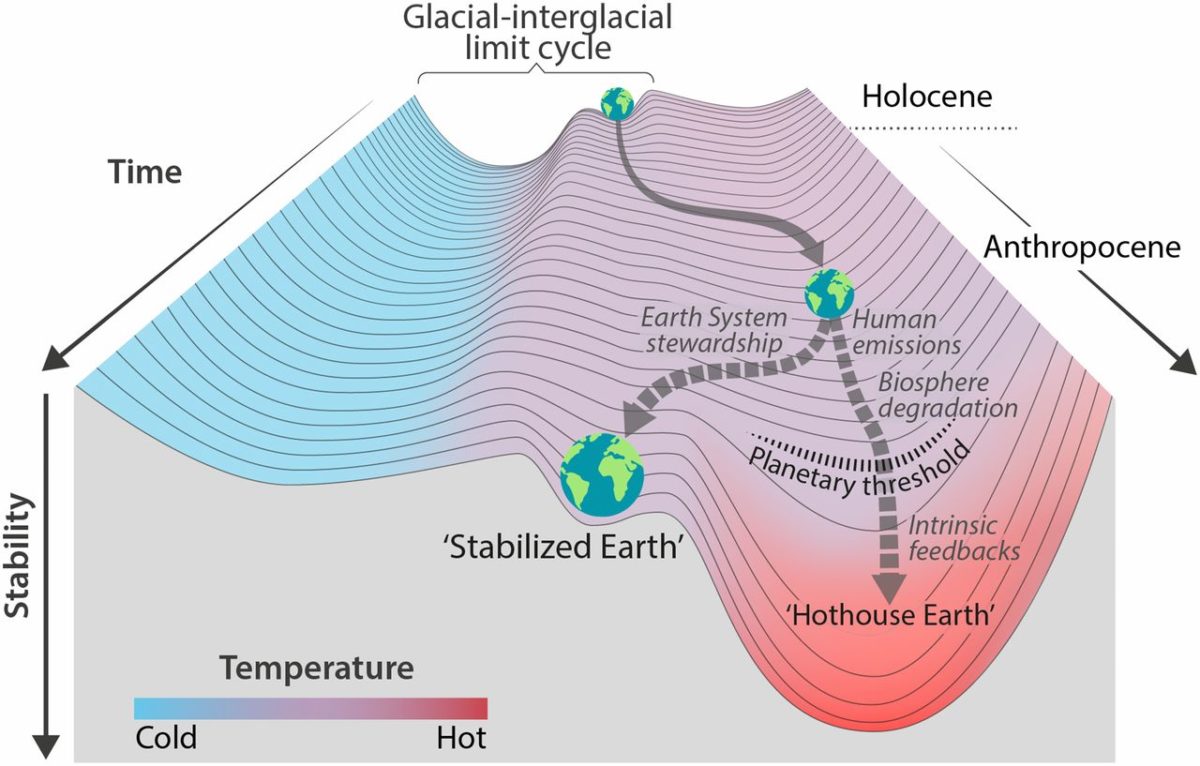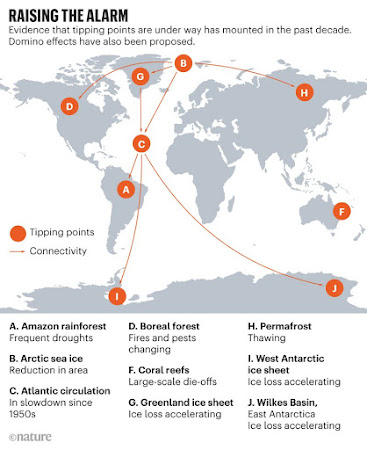Tripping down the road to Earth’s Hothouse Hell and Global Mass Extinction

In this article David Spratt explains how we have embarked on this road to Earth’s Hothouse Hell.

18 January 2022
Have tipping points already been passed for critical climate systems? (1) The basics
by David Spratt in Climate Code Red
First in a series.
As global heating reduces the extent of floating Arctic sea-ice each summer, the heat-reflecting ice is replaced by heat-absorbing dark ocean water, adding energy to the Arctic system, driving more melting. This is a “positive feedback”, a self-reinforcing change. Examples abound in the climate system. On Greenland, for example, warming is reducing the height of the ice, and this lower elevation means it will melt more, because the temperature is higher at lower altitudes.
Sixteen years ago, James Hansen warned that “We live on a planet whose climate is dominated by positive feedbacks, which are capable of taking us to dramatically different conditions. The problem that we face now is that many feedbacks that came into play slowly in the past, driven by slowly changing forcings, will come into play rapidly now, at the pace of our human-made forcings, tempered a few decades by the oceans thermal response time.”
Those feedbacks can drive non-linear (or abrupt) change that is difficult to forecast. That happened to Arctic sea-ice in the summer of 2007, when a collapse in the ice extent led one experienced glaciologist to exclaim that it was melting “100 years ahead of schedule”; actually, the scientific understanding was 100 years behind reality! The same thing is happening in Antarctica now, according to the new observations of the Thwaites Glacier.
For the full article ….
Spratt’s story will continue
Spratt warns us that more posts will follow in this series. One might relate to the unexpectedly rapid thawing of the Siberian permafrost (H on the map above) that holds at least two times more carbon Earth’s entire atmosphere.
This is something I have researched in detail with my own eyeballs using the original satellite scans. My findings are described in my graphical essay/presentation, “Portents for the Future – 2020 Wildfires on the Siberian Permafrost.” The authors of the tipping point papers Spratt cites and linked generally anticipated thawing of the permafrost would be one of the later tipping points. These authors certainly did not anticipate that all-time record temperatures would be recorded in 2020 above the Arctic Circle (due to Arctic amplification), or how this heat affected the rapid acceleration in frequency, extent, and ferocity of wildfires on the Siberian permafrost.
Spratt and I and a few other generalists (some of us with complex systems engineering backgrounds) can see that what is happening is well outside the boundaries of the IPCC’s super-conservative and bureaucratic approach to climate science that assumes that future climates can be predicted – at least in a statistical sense – by treating climate change as if it followed the universal laws of physics in a statistically repeatable way. However, even the IPCC’s tightly controlled conservative approach that only mentions the possibility of global mass extinction on one out of the 3949 pages of their recently released AR6 Report still shows we are well on the road to climate Hell.
As Spratt notes in the article here and I explain in detail in another graphical essay/presentation circulated earlier this month, “Some fundamental issues relating to the science underlying climate policy: The IPCC and COP26 couldn’t help but get it wrong“, climate change does not behave repeatably as one would expect in physics experiments. Climate is generated by a complex dynamical system of many variables interacting in non-linear and some times actually mathematically chaotic feedback loops such that climate change is actually unpredictable as one looks more than a few weeks into the future.
What this means for our future is that we are moving down the road to Hell farther, faster and sooner than anyone putting total faith in the IPCC’s complacent discussions of emissions budgets and 2050 net-zero targets would believe, and that the government and media puppets of the fossil fuel special interests are happy to refer to in their blizzard of optimistic humbug about a rosy future and keeping a vibrant coal burning industry going so there will be full employment.
The stark reality is that if we cannot very quickly mobilize a global effort to
- immediately stop human generated greenhouse gas emissions,
- engineer processes to capture and safely sequester a significant proportion of all the carbon in our planetary atmosphere, and
- enable to Earth to reflect away with out absorbing a significant fraction of the solar energy received,
we will soon have passed the point of no return where the natural climate feedbacks are warming the world sped up so fast that nothing humans could do would prevent temperatures from running away to Earth’s Hothouse Hell state. That climatic flip would, of course, lead to completion of the global mass extinction event we have already started. Humans would be among the 90% or more of Earth’s biosphere to go extinct (as happened in the End Permian mass extinction).
Our current LNP COALition Government is clearly comprised of puppets of the greedily gluttonous special interests of the fossil fuel and related industries that are exploiting Australia’s natural resources for minimal return to Australia or its citizens. To have any hope of generating effective action on climate change against the blizzard of humbug, lies, misrepresentation, misdirection, alternative facts, fake news, bulldust and blather that members of this government emit to provide subsidy, cover, and protection for their patrons, they must all be removed from office and replaced wherever possible by electingtrustworthy people who have made public commitments to make action against climate change their first order of business.
Vote Climate One is dedicated to helping you achieve this replacement (where needed) in every Federal Electorate by making it easy to use our Australian preferential voting system to full effect. This help is provided via our Traffic Light Voting System. If we can sterilize the pigpen our Parliament has become and replace it with houses of genuine leadership and legislation, we might actually be able to engineer a solution to the climate emergency that provides us with a path into a foreseeable future.
If you agree with the program outlined here, we are seeking like-minded volunteers to help us in this effort to change our Parliament as Climate Heroes or in any other way.